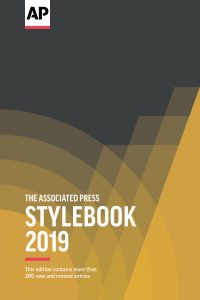It’s Called a Style “Guide” for a Reason
Published on October 27, 2019, at 2:00 p.m.
by Carlyle Ascik.
On Aug. 28, 2019, a statement of under 280 characters caused an uproar in the communications industry. When the Associated Press (AP) Stylebook account tweeted a timely reminder about how its recent hyphen update pertains to football season, many journalists and public relations professionals alike took to Twitter panic-stricken.
The AP Stylebook is widely known as the premier style guide for news writing. The purpose of the book is to increase “consistency, clarity, accuracy and brevity.” However, oftentimes writers regard the statements in the book as hard and fast rules instead of simple style guidelines.

“Think about traffic laws,” said Merrill Perlman, the former director of copy desks at The New York Times. “They’re rules — but even if the speed limit is 55 there are times when, say if it’s snowing, you’re going to go 35. So, you’re not following the rules. You’re following the situation; you’re following what’s needed now.”
The same should go for the parameters in the stylebook. While it may be easier to teach, edit and write based on a set of concrete rules, style guides rely on the insights and judgment of the writer to decide what action is appropriate for the given situation.
Thus, changes to the AP Stylebook aren’t just made to disrupt the lives of our nation’s journalists. Since the first AP Stylebook was published in 1953, it has seen its share of both major revisions and slight edits. Throughout its history, the guide has continued to evolve alongside the communications industry.
With the rise of technology, more individuals than ever before are able to communicate with the editors at the Associated Press. Whether it’s through a tweet or a submission to “Ask the Editor,” there is an increasingly large number of avenues between the everyday writer and those writing the rules. While this open communication leads to more frequent updates to the stylebook, it also means those changes are more relevant and necessary to the readers.
When Perlman started out at The New York Times over 30 years ago, it was frowned upon to use “contact” as a verb. Despite the term being listed in the dictionary, she spent many years finding alternative phrases to replace the verb. However, with the rise of email communications and contact lists, the term eventually became widely accepted.
“Language changes because we think about the rule, and well it doesn’t fit here and I’m going to change that — and then people start talking,” said Perlman.
Despite his personal distaste for the recent percentage sign change, Seth Maxon, associate editor at Slate, recognizes that the change to its use is a sign of the times.
“The ubiquity of digital communication and social media has changed the way that people think about the norms of writing,” said Maxon. “When you’re typing, it’s faster to hit just one key than to type out a whole word. This is happening in a number of ways that the style guide has had to adapt to.”

While some changes to the style guide are solely for the sake of clarity and conciseness, others are a reflection of major cultural and political changes in our nation. At this year’s Annual Conference of ACES: The Society for Editing, one of the main themes amongst AP style updates was race. From dual heritage hyphens to cultural group nicknames, the book editors made large strides in updating its race-related entries.
“It’s a reflection of what’s going on in the real world — in America,” said Maxon. “Not only online but everywhere, minorities or people who have been traditionally discriminated against have more access to authoritative positions and more of a voice than they have ever had before. I think it is laudable that the AP style is taking the concerns of these groups so seriously and incorporating them into the guide.”
Although these changes were positive in nature, they also seemed somewhat overdue. The debate between whether to use the term “Indians” or “Native Americans” is long resolved; however, this year’s stylebook is the first to recognize “Indians” as solely individuals from South Asia or India.
“Stylebooks follow, they don’t lead,” Perlman explained. “If a stylebook led, their audiences might not be familiar with things. For that reason, they are always somewhat lagging culture.”
Despite its timing, the AP Stylebook seems to have its finger on the pulse of society — and it’s not planning on becoming obsolete anytime soon.
“Companies use the stylebook as a way to keep their own copy consistent,” said Maxon. “It is not so much about right or wrong as it is giving the reader a consistent look, sound and set of meanings that they can rely on — whether they realize that they are or not.”
So, while it may be easy to complain about yet another change to this writing rulebook, remember to take a step back and understand the true purpose of any style guide. It is the responsibility of the writer alone to determine how to proceed based on both the guides laid out in the stylebook and the writer’s discretion in a given situation. So, write on, and always let the AP Stylebook be your guide.




